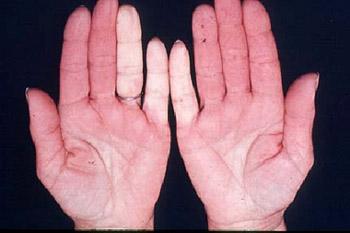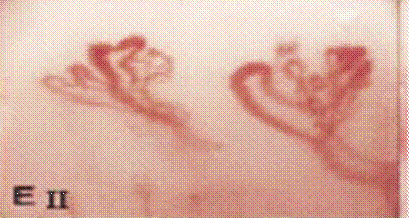Raynaud phenomenon refers to episodic color changes of the fingers and toes in response to cold and in some cases emotional stress.
Not everyone has the classic full sequence of color changes. The typical episode begins with the fingers turning pale or white. This is from spasm of the small arteries which bring blood flow into the fingers (see photograph). The white phase is usually followed by a blue/purple phase. This is thought to be the result of spasm of the veins which drain blood flow from the fingers. The final phase is one of excessive redness related to increased return of blood flow to the fingers after the initial spasm.

Raynaud phenomenon is known to occur in around 10% of the healthy female population and in around 5% of men. In the vast majority of cases, the blood vessels show no evidence of damage. In this case - so called Primary Raynaud phenomenon – the issue appears to be exaggerated spasm of healthy blood vessels.
Raynaud phenomenon is also the most common first symptom of scleroderma and is an important feature in other rheumatologic illnesses such as lupus. In this situation, the blood vessels are damaged and the opening for blood flow is much reduced. Raynaud episodes in scleroderma may reflect normal blood vessel constriction in response to cold superimposed on the narrow plumbing.
Blood flow to the fingers in normal health is around 40 times as much as is needed for oxygen supply and tissue nutrition. When the body is hot, blood flow increases to the hands so as to dissipate heat. This is much like a dog panting on a hot day. Conversely, when the body is cold, it is normal to reduce blood flow to the hands thus conserving central body temperature. All patients with Raynaud’s are unusually sensitive to even mild cold temperatures and may have difficulties holding cold drinks, reaching into the freezer or staying outdoors on a cool day.
How is Raynaud Phenomenon Diagnosed?
The diagnosis of Raynaud phenomenon is diagnosed by simple questions and answers about cold-induced color changes. The tougher issue is assessing whether or not the Raynaud phenomenon is primary or secondary to an underlying blood vessel disease like scleroderma. Your doctor may ask a variety of other questions about your health in an effort to identify signs of related diseases. Blood tests for scleroderma and lupus are usually positive even at very early stages of illness and can be instructive as well. Specialists may closely examine the capillary circulation at the base of the fingernails looking for the characteristic damage changes of scleroderma.

How is Raynaud Phenomenon Treated?
All patients with Raynaud phenomenon (no matter what the cause) can benefit from simple common sense measures. These include:
- Dressing warmly – Wear layered clothing over the chest and abdomen to “trick” the body into thinking it’s warm. Wear hats – 20% of body heat loss is through the scalp. Mittens are better than gloves for keeping the fingers warm.
- Plan your day with common sense – Have someone warm the car up for you. Schedule your activities to avoid prolonged cold exposure. Learn and understand your tolerance for cold.
- If you smoke – STOP!! Avoid passive smoke. The blood vessel constricting effects of smoking are so strong as to minimize the possible benefits of all other maneuvers including medication.
Many patients can manage their Raynaud phenomenon without medications. If medications are necessary, there are a variety of options. There are no drugs that are FDA approved for the indication of Raynaud. Nonetheless, certain agents used for high blood pressure and heart disease can be helpful. These are prescription drugs and your physician can guide you through the choices.
